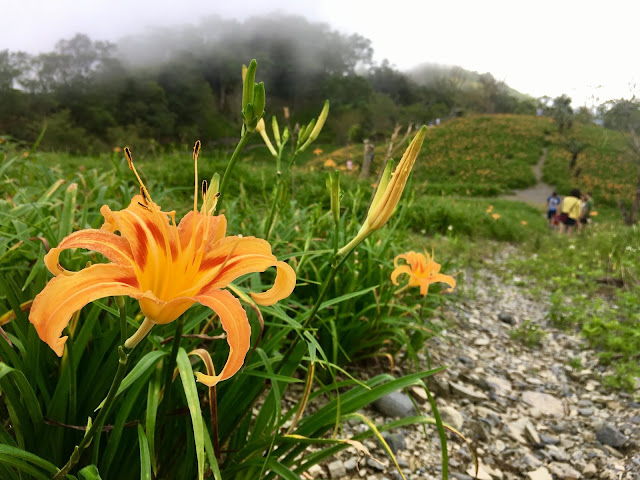Travel Date: 2019/08/31-09/02
I prepared for this trip a long time in advance. I searched for places on Google Maps about a month before we went. I felt like checking every place where someone had added photos... It was a bit of an annoying thing to do, but I hoped to find places that not many foreigners had been to. Also, my husband's uncle showed us some places that local people would go.
We had planned an 8-day holiday in Taidong and Hualien. Unfortunately, we had to return after only 3 days due to our son's illness. Nonetheless, we still managed to see a few places around, which I will post about in the future. We started our journey by visiting Jinjinshan in Taimali. It took about 4-4.5 hours to drive there from our place in Shanhua, Tainan. One important thing to note is that if you want to drive there, please don't rely solely on GPS in the mountains. It's better to follow the signs on the road, as the GPS often led us astray. The sea view from the hills was incredibly beautiful. I had hoped to see two other mountains with those flowers in Hualien, but unfortunately, we didn't get the chance. Hopefully, next year we can return to the east of Taiwan. It was truly an amazing view that I won't easily forget.
See also: Daylilies in Hualien


In eastern Taiwan, the mountains are the main places to witness the blooming of daylilies, also known as Golden Needle Flowers (金針花) in Chinese. Every August to September, the mountains become covered with orange flowers. The flowering of daylilies lasts less than 24 hours, with the flowers opening in the morning and being replaced by new ones every night.
To reach Jinjinshan, you can take the industrial road along the Taima Lixi River from Taimali Station. The whole journey is 11 kilometers and takes about 35 minutes. The scenery along the way is beautiful, even outside of the golden needle flower season, making it a worthwhile trip. Local farmers also plant many cherry blossoms on their farms, which are in full bloom from the end of January to March, attracting artists who come to paint the beautiful scenery.
Daylilies are native to Asia, with more than 80,000 cultivars of these flowers. Taitung has an area of 3,800 hectares planted with daylilies, covering towns such as Taimali, Chihshang, Jinfong, and Changbin. The most popular area that attracts many travelers is Taimali, where daylilies are planted at an altitude of 1,450 meters above sea level. The low temperatures and high humidity in this area create the perfect conditions for growing these flowers. Daylilies are known for their ability to adapt to different environments. The golden needle flower is grown and cultivated at altitudes of 700 to 1,000 meters, mostly in mountainous regions. This area is famous for the golden needle flower, attracting a large number of tourists during the summer season. The viewing or harvesting period lasts from June to December every year, with the best viewing period being from August to September. Nowadays, most of Taiwan's golden needle flowers are grown for both culinary and ornamental purposes.
Due to their beautiful flower pattern and bright colors, daylilies have earned the reputation of "beauty of the day" in Europe and America. In Chinese, they are also known as the "Mother Flower." The name "Golden Needle" and "Yellow Cabbage" refer to their color, shape, and use. Daylilies are cultivated for culinary purposes, especially in soups, and are sold to many restaurants around Taiwan. Nearly all parts of the daylily plant are edible and can be eaten raw, cooked, or deep-fried. The flowers can also be steamed and dried to create dried vegetables. Additionally, daylilies are used as a natural dye. They are rich in protein, fat, and carbohydrates, and contain vitamin C, carotene, calcium, and potassium. The roots of daylilies contain anti-tumor compounds and can provide various health benefits such as pain relief, anti-vomiting properties, muscle relaxation, fever reduction, and aiding sleep.
The cultivation of daylilies in eastern Taiwan began in 1959 after a tragic flood that damaged thousands of hectares of farmland in central and southwestern Taiwan. Many farmers relocated to Hualien and Taitung and started growing daylilies. The original species of daylilies came from Alishan, which was once the center of daylily farming. However, the fields in Alishan have been mostly replaced by tea plantations. In 1997, the Taimali Farmers Association started promoting tourism and advised planters not to pick flowers before they bloom. This campaign was highly successful, and farms began operating restaurants and accommodations for tourists. Approximately 15% of daylilies are allowed to bloom to attract visitors. In 1990, a new species of daylilies was developed in Taitung, which can grow from sea level up to 200 meters. This led to an increase in daylily cultivation in the region.




















%202%20(8).jpg)

0 komentarze:
Post a Comment